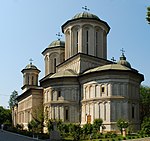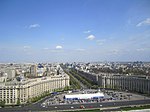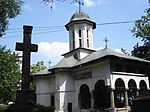Bucur Church
17th-century Eastern Orthodox church buildingsHistoric monuments in BucharestRomanian Orthodox churches in Bucharest

Bucur Church is a church which formerly served as the chapel for the Radu Vodă Monastery. There is no exact date for the building of the church and this has been the subject of much discussion among Romanian historians. For a long time, many historians have insisted that the building is in a style specific to the 18th century, while others have held to the legend which claims that the church was built by the shepherd Bucur, whose name is also associated with the name of the city of Bucharest. The church is first recorded on a map drawn up between 1844 and 1846 with the name of the Bucur Church.
Excerpt from the Wikipedia article Bucur Church (License: CC BY-SA 3.0, Authors, Images).Bucur Church
Strada Radu Vodă, Bucharest Centrul Civic (Sector 4)
Geographical coordinates (GPS) Address Website External links Nearby Places Show on map
Geographical coordinates (GPS)
| Latitude | Longitude |
|---|---|
| N 44.423538888889 ° | E 26.108833333333 ° |
Address
Biserica Ortodoxă „Bucur Ciobanul” (Biserica Ortodoxă „Sfinții Atanasie și Chiril”)
Strada Radu Vodă 33
040273 Bucharest, Centrul Civic (Sector 4)
Romania
Open on Google Maps










